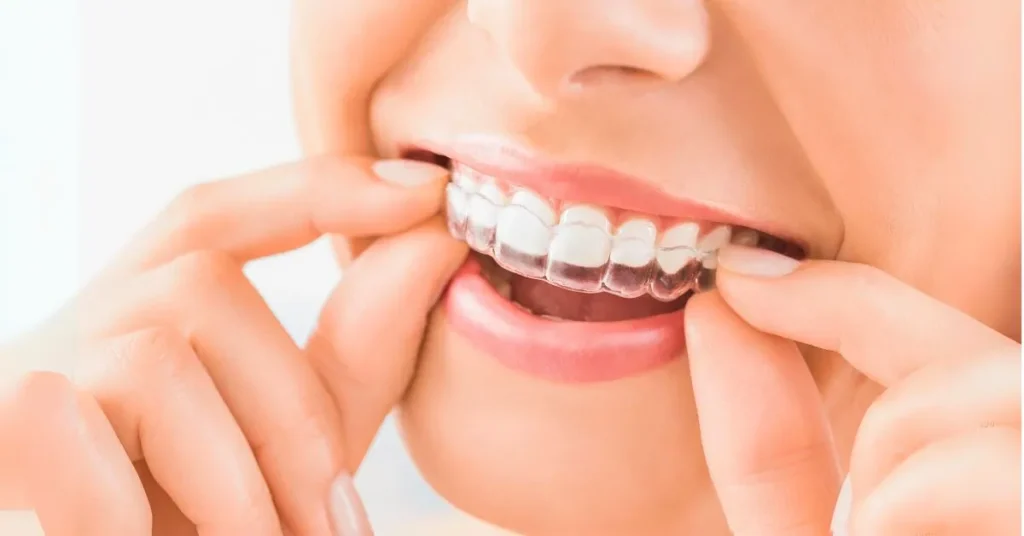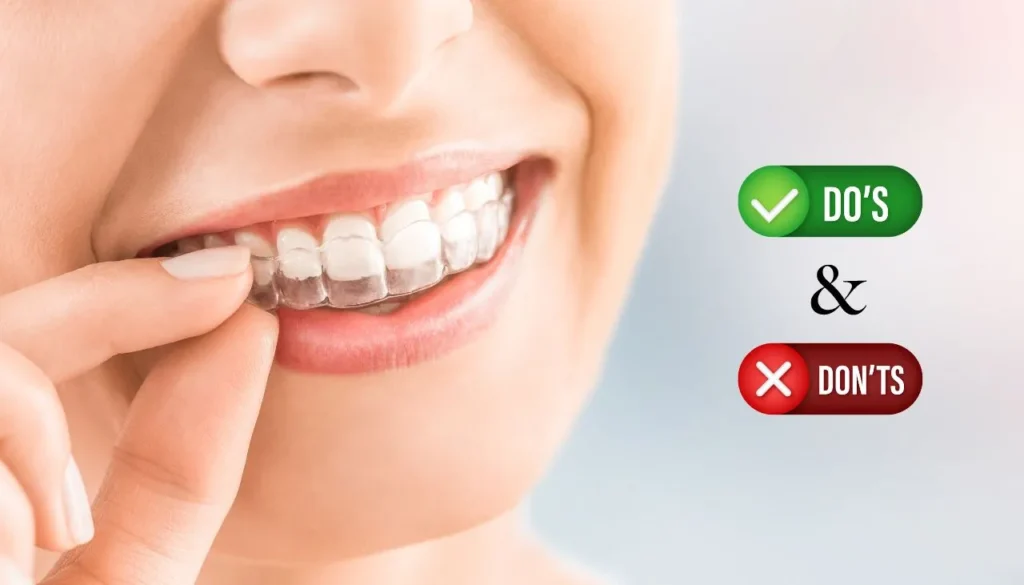Every good thing requires good maintenance in order to furnish stunning outcomes. Clear aligners are not exceptional. If you are dreaming of a beautiful smile you should take adequate care of your clear aligners.
The Importance of Cleaning Clear Aligners
Clear aligners, as the name suggests, are clear medical-grade plastic-made transparent trays that snugly fit your teeth to keep guiding them towards their ideal place. These advanced orthodontic devices are great for brilliant and fast results, but only if you can maintain them.
Just as brushing teeth every night is important, knowing how to clean aligner trays is vital for oral health.
First, one of the reasons that people prefer clear aligners over braces is their invisibility. However, they need to be cleaned regularly to maintain their invisibility or transparency. Otherwise, stains will form on the trays, and they will start becoming discoloured or yellowish over time.
Good oral hygiene practices keep the aligner trays invisible and help prevent bad breath. With everyday usage, it is very common for food particles to get trapped in the aligner trays. This can encourage the spread of bacteria, which, in turn, causes bad breath and even other oral discomforts. Regular cleaning can help keep the mouth smelling good.
Also, cleaning the trays regularly helps prevent tooth decay. Food particles stuck between the teeth and on the aligners are the key reason for developing tooth decay. Bacteria feast on the food debris, causing plaque, which in turn causes cavities and gum disease.
These oral issues are not only uncomfortable and costly to treat but also extend the duration of treatment by causing unnecessary and added complications. So, the way to successful treatment with clear aligners is to maintain your oral hygiene and aligner trays.
Effective Cleaning Techniques
Daily cleaning:
It is mandatory to clean your aligners whenever you remove them to eat your meals.
Brush your aligners with a soft-bristled toothbrush (different from your regular toothbrush; it will be available at your orthodontist) and lukewarm water after each meal.
Rinsing with clear water throughout the day is also helpful for additional cleaning.
Weekly deep cleaning:
Deep cleaning of aligners includes soaking your aligners in a cleaning solution. It can help remove bacteria and prevent odours from your aligners. It is a dentist-recommended cleaning step that needs to be followed once or twice a week.
You can use a commercial cleaning solution or make your own by mixing equal parts water and hydrogen peroxide or water and vinegar. Soak your aligners for 15-20 minutes, then rinse them thoroughly with cool water. Soaking options include trying to deep clean your aligners.
- Antibacterial soap and water soak: You can soak your aligners in liquid antibacterial soap and hydrogen peroxide for 15-20 minutes. Then, you can manually scrub the aligners with a soft-bristled toothbrush to remove any remaining bacteria.
- Baking soda and water soak: You may use vinegar or baking soda for its deodorizing properties, which are very effective in cleaning plaque and tartar.
- Cleaning tablets: Cleaning denture tablets are specially designed to clean and disinfect aligners effectively.
- Whatever the solution may be used, never soak your aligners for more than 30 minutes. Rinse thoroughly with water after each soak.
Pro-Tips for effective cleaning
- Never use hot water to clean your aligners, as it may damage the tray.
- Avoid harsh chemicals, toothpaste, mouthwash, or any harsh cleaning solutions to prevent causing damage to your clear aligners.
- Never leave your aligners soaking for extended periods. The ideal time for soaking a clear aligner tray is 15-30 minutes. Prolonged soaking may cause severe damage to the product as the material can be weakened by the solutions.
- Clean your aligner case regularly using liquid antibacterial soap and clear tap water to clean the case.

Dos and Don’ts of Aligner Cleaning
Dos:
- Rinse your aligners before removing them, it will help to remove saliva, food particles, plaque and prevent bacterial colonization.
- Remove your aligners while eating and drinking, especially fruits, sauces, and flavoured beverages. These are extremely harmful to your aligners, as they will leave their colour on your aligners and affect their quality.
- Always handle your aligners with clean hands.
- Do regular brushing and flossing of your teeth before you wear the aligner. The better the oral hygiene, the more efficiently your aligners work.
- To clean your aligners, you may use the kit provided by your orthodontist or clean it gently with regular toothpaste using a soft bristle toothbrush. This is the best way to keep your aligners clean.
- When you are not using your aligners, Use the aligner carry case provided to you in the kit and store them in a cool, dry, safe place. This will increase the life of your aligners.
Don’ts
- Do not store them anywhere, e.g., on your table or desk, in napkins, or on a piece of paper.
- Never use coloured soap to clean your aligner.
- Don’t use common toothpaste to clean your clear aligners. Most toothpastes contain a whitening agent, which will damage your clear aligners and make them blurry.
- Never leave your clear aligners dirty. Clean them regularly, especially when you eat or drink highly-pigmented food or liquid. If not cleaned properly, the residual pigmentation may make your clear aligners visible.
- You should avoid using denture tablets to clean your clear aligners. These tablets will cause them to fade and become yellowish.
Recommended Cleaning Products and Solutions
Cleaning Crystals: cleaning crystals are a quick and convenient way to free your aligners from bacteria and plaque. They help remove food particles, destroy odour-causing bacteria, and prevent discolouration of your aligners.
Antibacterial Soap: Regular antibacterial soap is effective for cleaning clear aligners, as long as you use a soft-bristled toothbrush.
Mouthwash: Mouthwash is another safe and effective way to keep your clear aligners free from bacteria. Mix a small amount of mouthwash with lukewarm water, soak your retainers for 15 minutes, and then rinse thoroughly with plain water.
Toothbrush and Toothpaste: Brushing your clear aligners with a soft-bristled toothbrush and toothpaste is an easy and effective way to keep them clean.
Baking Soda and Hydrogen Peroxide: Baking soda is a mild abrasive that is great for removing surface stains from your aligners, while hydrogen peroxide acts as an antibacterial agent to help kill off any bacteria that may be present.
Recommended Ways to Protect Your Teeth
Brush two times a day: The general thumb rule for maintaining oral hygiene is to brush twice a day, in the morning and before bed.
Do not overbrush: Brushing twice daily is enough to keep your oral health neat and tidy. Brushing more than twice a day will probably harm your teeth and gums.
Do not use pressure while brushing: While brushing your teeth, remember not to put pressure. If you put more pressure than enough, it may lead to enamel wear and loss. If your brush looks like someone has sat on it, you are putting extra pressure on it.
Floss every day: Flossing removes plaque and prevents the buildup of tartar. While brushing plaque away is easy, you need a dentist to remove tartar.
Avoid soda and sugary drinks: Sugar and acid in soda attack teeth and eat away at enamel. They also create cavities, leaving stains on the tooth surface.
Final Verdict
Regular cleaning of your aligners is vital to ensure they remain clear, hygienic, and effective. Proper cleaning will help them last longer and perform better, allowing you to enjoy the benefits of a straighter smile faster and with less hassle.
Proper hygiene will also prevent bacteria and plaque build-up, helping to keep teeth and gums healthy. With clear steps and consistent effort, you can easily maintain your aligners and keep your smile looking its best.
FAQs
You should clean your aligners every day whenever you remove them for eating.
Generally, toothpastes are too abrasive for your aligner material. However, your orthodontist may recommend toothpaste that can be used to clean your aligners.
Before proceeding, you should seek your orthodontist’s recommendation. There are several denture cleaners available in the market that can be harmful to your aligners.
For effective cleaning, you may use antibacterial soap, baking soda, or other solutions prescribed by your orthodontist to deep clean your clear aligners.
Always rinse your clear aligners in normal or lukewarm water. Never put hot water or boiling water on your aligner as it may damage the aligner tray.
You should clean your aligner case thoroughly once or twice a week.
Only orthodontist-recommended non-coloured mouthwash is the best choice for cleaning your aligner trays.

